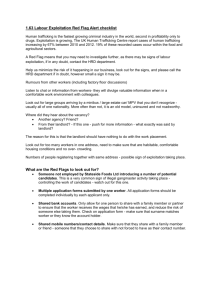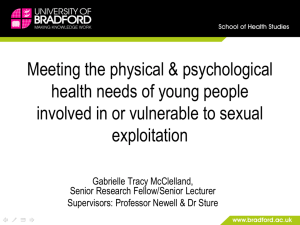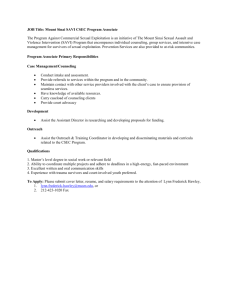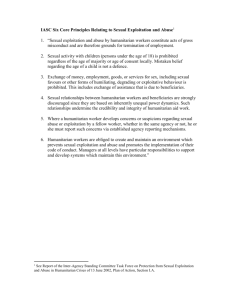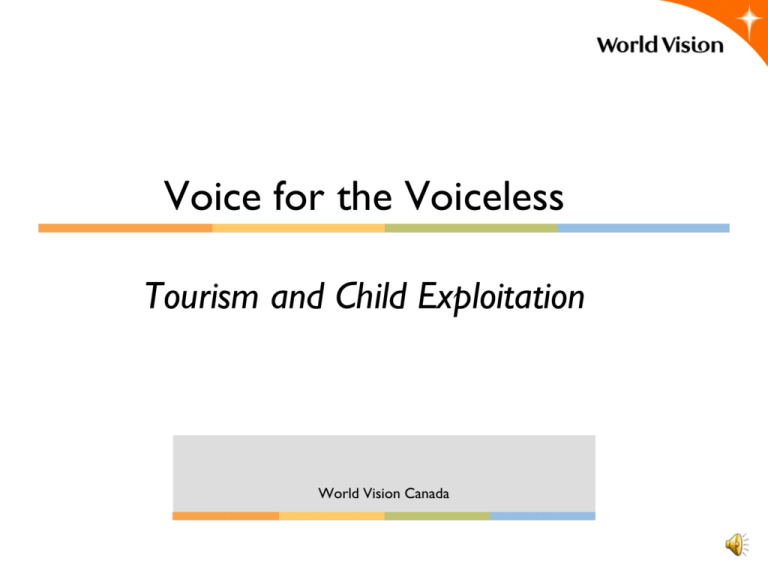
Voice for the Voiceless
Tourism and Child Exploitation
World Vision Canada
Who is World Vision?
• A child-focused international development, relief, and
advocacy organization
• We work in nearly100 countries and work alongside
communities to find sustainable ways to bring them
out of poverty
• Witnessed first-hand the impact of sexual exploitation
of children including exploitation in the travel and
tourism sector
• Cambodia, Thailand, Philippines, Costa Rica,
Brazil, Mexico, etc...
• We work to prevent child sexual exploitation, protect
those children who are in exploitative situations and
rehabilitate them, and partner with children and
parents, communities, police and government to
create protective environments for children
What is Child Sexual Exploitation in
Travel and Tourism?
•
Conservative estimates suggest 2 million children are victims of commercial sexual
exploitation through child sexual abuse images, trafficking for sexual purposes, and
sexual exploitation by tourists and travelers
•
Form of human trafficking: child trafficking occurs when a child has been moved
within a country or across borders, whether by force or not, with the purpose of
exploiting the child
•
Children experience physical, emotional, and psychological trauma and bare these
scars for life often perpetuating cycles of poverty
•
Ex: Story of Ka in Cambodia
Supply and Demand
1. Supply:
• Developing countries have the highest rates of child sexual exploitation in tourism:
• Children are vulnerable to sexual exploitation
• Impunity and corruption
• Big business
• Human trafficking has estimated annual profits of approx. US$31.6
billion and is the third largest grossing sector of organized crime after
drugs and arms.
• Sex with a virgin in Cambodia can sell from USD 300 - 700
2. Demand:
• Increasing demand for sex by regional and international tourists including Canadians
• 2 types of offenders: preferential offenders and situational offenders
WV’s approach
•Create a protective environment for children from community level
to national level
•All stakeholders in the community are part of the solution
•World Vision works in the local communities to educate and to
restore and rehabilitate children. World Vision also works with the
government and travel industries.
World Vision partners with the Tourism
and Travel Industry:
• Campaigns targeting potential child sex offenders
- partnered with US Airways, TAM Brazilian airline
- worked in source countries, en route, and in destination country
• Awareness-raising to general public on what their role is, asking Canadians to
travel wisely:
• Take responsibility for the impact of their own travel by researching hotels
and travel companies to ensuring codes of conduct have been signed to
protect children
• Report the exploitation of children – labour, sexual or trafficking – that they
witness while abroad (www.cybertip.ca)
• Deter any travel companions from engaging in such behaviours
Canada’s obligations under international law:
2000: Canada ratified the Convention on the Rights of the Child, along with the ILO
Convention No. 182 (on the abolishment of the worst forms of child labour,
including child prostitution)
2002: Canada ratified the Protocol to Prevent, Suppress and Punish Trafficking in
Persons, Especially Women and Children (Trafficking Protocol)
2005: Canada ratified the Optional Protocol on the sale of children, child prostitution
and child pornography
Canada’s Legislation
1997: Bill C-27: An Act to amend the Criminal Code (Extraterritorial legsilation: made
it a crime to sexually exploit children anywhere in the world)
2001: Bill C-15A: An Act to amend the Criminal Code and to amend other acts
(eliminated the need for double criminality)
A question of implementation in Canada:
•
•
•
Canada has all the right laws in place to combat child sexual exploitation of
children but has failed to put the resources and political will behind implementing
and enforcing its laws.
• “child sex tourism offences are among the most under-enforced in the entire
Criminal Code”, Benjamin Perrin, Law Professor UBC
Unclear how many Canadians have committed sexual crimes against children
abroad
• 4 persons convicted under extraterritorial legislation
• Vs. much higher conviction rates in other countries such as Australia, UK,
US
• Vs. strict limitations on travel for convicted travelling sex offenders
• Between 1993 and 2008: Canada provided consular service to 150 men to
deal with charges of child sexual abuse and exploitation offences laid against
them in foreign countries
RCMP liaison officers abroad are few and are not given a strong mandate to
combat child sexual exploitation in tourism
Travel and Tourism Industry Voluntary
Codes:
-
•
Code of Conduct for Protection of Children from Sexual Exploitation in Travel
and Tourism (www.thecode.org)
- Tourism companies who adopt the code (voluntary) agree to:
• 1. To establish an ethical policy regarding commercial sexual exploitation
of children.
• 2. To train the personnel in the country of origin and travel destinations.
• 3. To introduce a clause in contracts with suppliers, stating a common
repudiation of commercial sexual exploitation of children.
• 4. To provide information to travelers by means of catalogues, brochures,
in-flight films, ticket-slips, home pages, etc.
• 5. To provide information to local "key persons" at the destinations.
• 6. To report annually.
As of November 2009, 947 companies in 37 countries have signed up, only 2
Canadian companies have signed on: the Association of Canadian Travel Agencies and
Incursions Voyages (Quebec City)
What steps have been taken by / for
Travel Tourism Sector in Canada:
-
As of 2010, Group of Canadian NGOs working with tour operators and Air
Canada to dialogue and create awareness-raising materials for distribution to their
colleagues and clients.
- Goal is to create a critical mass of informed Canadian travelers and tour
operators
- Showing an on-flight video: http://www.youtube.com/watch?v=PYtAfe213ko
-
Canada has never had a large public campaign against Child Sexual Exploitation in
Travel and tourism.
- NGO group is also creating posters in Canadian airports, starting in Quebec
alerting travelers that abusing a child in a foreign country is a crime you’ll be
held accountable for in Canada. Working to expand campaign to other
airports
More Progress Needed in Canada:
-
Without political will and an increase in resources to tackle this issue, it will be
difficult to combat child sexual exploitation by Canadians abroad
Canadians need to be engaged and push the Federal Government to make this a
priority and to demand ethical travel of their service providers
Key partner in the fight against child sexual exploitation is the travel and tourism
industry
- Need greater peer pressure within the industry
- Need to see adoption of the code or similar standards
World Vision’s Trauma Recovery Centre
Cambodia
-
-
Child protection in Cambodia
- Girls made vulnerable by the sex trade
- Property of brothel owners and bound by debts
- May serve up to 10 customers a day
Girls in Crisis Facts
- 33,000 child sex workers in Cambodia
- Have no rights and used as sex slaves
- Worldwide estimate that 2 million children are exploited in the sex trade
- Trafficking of people has effected an estimated 30 million victims
- Estimated 20,000 children are living or working on the streets in Cambodia
World Vision’s Trauma Recovery Centre Cambodia
-
Cambodia Trauma Recovery Centre is a place of hope for young girls trapped in
sexual slavery
Goal is to help girls heal and reunify them with families and reintegrate
Centre offers stays from 6-12 months
Teaches girls their rights and provide nurturing environments
Offer health care
Provide education and vocational training
Arrange foster care or independent living
Conduct awareness sessions to create awareness about “brokers”
Partner with local government
THANK YOU

